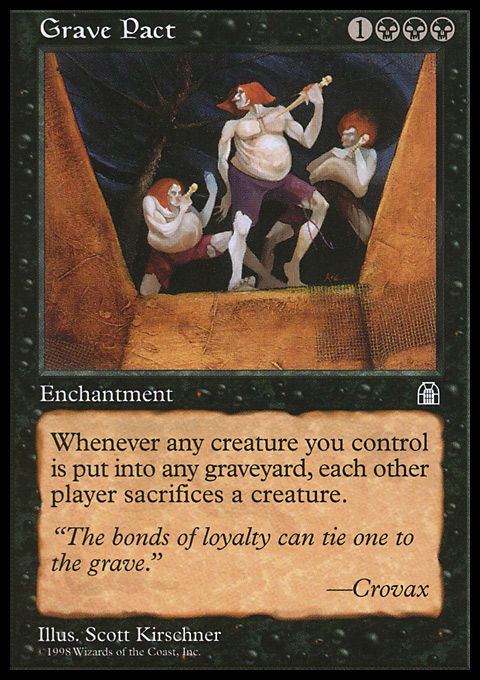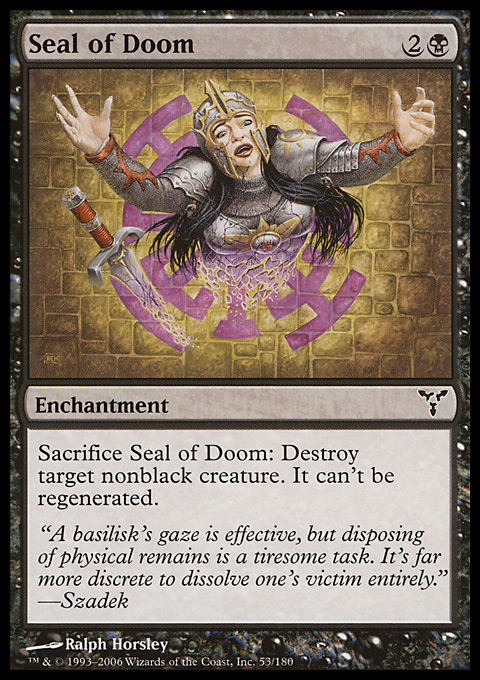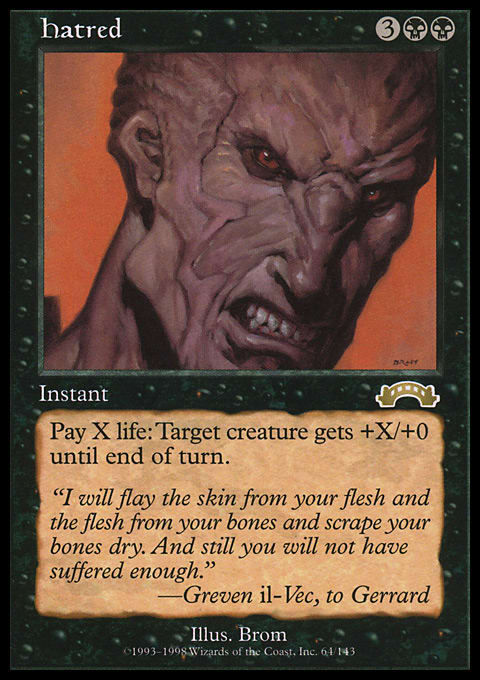I never grow bored with Magic. It is a game of perpetual rediscovery and invention. It’s LEGOs for adults, and one’s the decks are built, it’s chess. I have over seventy decks constructed, and the oldest has been tinkered with for over ten years. No matter how similar some of my decks are (I tend to lean on recursion, for example), I strive to give each of them a soul of its own and make it impossible for someone to create a single deck, or even a series of decks, that can foil all of my creations.
For this reason, and because I have access to most "broken" cards, I impose a seventy-five-card handicap upon myself and self-restrict cards that begin to warp my metagame. This leads to more enjoyable games for me and my opponents. Especially for those of you who are new to Magic, though, I entreat you: Use twenty-four to twenty-six lands and sixty-card decks. Decks constructed in such a manner will fare better, generally, than decks that are not. So, my decklists will only be baselines; which is good, as you will be able to enjoy the creative process of constructing your own deck.
Continuing with creativity, when I consider the multitude of pieces in this game, I am overjoyed to find that old favorites can be used in new ways and that cards that I always found intriguing will sometimes finally work. It is in this spirit that I am creating a series of articles about cards that I have found that interact with common strategies for playing this game. My goal is to share cards that I have discovered—or rediscovered—that affect others and change the game so that rediscovery and invention are facilitated and made necessary. The cards I will highlight will be cards listed as under $2, and most will be well under $1. This is a budgeted list.
If you are willing to heed my suggestions, these cards may help you inject more joy into your games. There is little fun in doing the same thing or fighting the same strategy over and over. If you periodically change strategies, colors, and goals, you will create a better environment. Decks jockeying for position and cards being played in reaction to others' creations is a dynamic and fun metagame. Plus, you are unlikely to hear the dreaded question, "Really, you brought that again?" Finally, the cards suggested will be cards that can be added to shake up how people play. My first articles will be for dealing with the deck-builder who likes to create a single, big beater or creature with powerful abilities fast, through reanimation, enchantments, Equipment, and fast mana.
Usually, these creatures are hard or impossible to target, indestructible, regenerators, or just so big (or have great abilities) that they run you over. I start with this list because this is a flaw of my decks. In recent years, my decks have moved away from spot removal and early answers as, in a vacuum, mass removal is just better.
Most Internet pundits have come to this conclusion as well. This will be my attempt to make the case for spot removal and early, sometimes even non-permanent, answer cards. The reality is that you may not last long enough to use the mass removal or it may be detrimental to your survival to use it. One player may suit his green fatty up with Whispersilk Cloak and go to town, or another's Niv-Mizzet, the Firemind may burn you to death long before you cast your answer. Plus, mass removal affects everyone, and especially against someone with the awesome-creature game plan, you don't want to hurt your temporary allies as you fight against The Threat.1
I recall a three-player game in which a friend and I were stomped by my dad playing Eldrazi. Neither one of us was playing cheap spot removal (e.g. Swords to Plowshares). It was early game, and we were beaten down by one of the "little" Eldrazi. His deck preyed upon a common assumption of multiplayer: that there will be a late game. These decks put out a great threat early and make sure that powerful late-game spells are never cast because there is no late game.
We could have complained that it was unfair, but we knew better. We have been playing for years. Also, I was playing my R/W soldier deck that blows up lands with Keldon Firebombers, and my friend was playing his Garruk-haups deck (Garruk Wildspeaker ramp with Jokulhaups), so it isn't as though we were playing any fairer. One of us could have won if we had early removal to assure that we could make it to the late game.
My dad actually likes this type of deck quite a bit. Another example involves my oldest deck, which revolves around Grave Pact. In that game, my dad recognized it, and he was playing a deck that powered out a quick Simic Sky Swallower. He knew that if he killed me, he would probably win. Barring mass removal, which he could save counterspells for, nothing could stop the Sky Swallower once it hit the table. I almost had the Grave Pact online—almost. Spot removal for his accelerators would have bought me the time I needed. After killing me, he steamrolled the other four players. I still need to go back and add some early removal to make sure the deck can make it to the late game.
Another time, I recall being beaten down by my dad's Skyhunter Skirmisher suited up with three copies of Taste for Mayhem. He did lose after killing three people. The Skyhunter was bounced by the last player. Who plays bounce, you may ask? Maybe you should—so you can make it to the late game.
The first five articles will focus on black, as it has an exceptional number of cards that are good against the large-threat game plan.
The first category of cards is those that ward off other players (a.k.a. rattlesnake cards, as revisited recently by Abe Sargent). What I really like about rattlesnakes is that they leave the threat on the table. The reason that this is good is that it can send that threat toward others, or at the least, it leaves the creature on the board making an opponent seem more threatening than you. Your rattler could be eliminated or made invalid as well, which provides your other opponents even more incentive to deal with the creature.
Deathtouchers are excellent rattlers. The first guy on the list is the card that started me on this path: Vampire Nighthawk. This list developed as a running way of dealing with the ’hawk because one of my friends was miffed by how it was warping his multiplayer games, as it was so powerful for its mana cost. This suggests ’hawk’s weakness: He is hated beyond all reason in many playgroups, and some players might kill him just because he is there. Well, it’s not beyond all reason. He does have great utility and is a threat at all points of the game. He should also be easier to acquire since he was just reprinted in Magic 2013!
The next card, Nirkana Cutthroat, is also exceptional, won't receive as much attention as the ’hawk, and becomes very threatening later. If you have alternate ways to deal with flyers or a way to give Nirkana Cutthroat flying, he might be better than the ’hawk because of his lower profile. Onyx Mage also deserves a passing mention here, as he can hand deathtouch out, and he stays under the radar well. He is quite fragile and requires activation, though.
The excellent Stinkweed Imp is next. He has built-in recursion and can pick up Equipment or Auras later to become a threat. There are two caveats, however. Your opponents will think you are up to something as you shove card after card in the grave (and you are up to something, aren't you, or you would have picked a different card, right?), and some opponents will be willing to attack you/kill it over and over just to watch you mill away your deck. "Some men just want to watch the world burn."
Seal of Doom is a classic rattler and is a great solution to something like Emrakul, the Aeons Torn. The deathtouchers are viable against him, but that means you have been annihilated. Unless your opponent is playing with something such as Krosan Grip,2 the Seal of Doom can kill Emrakul at any time. Obviously, the opponent can still annihilate you if you let him attack, so read the board and kill it before attacks if you think it is coming your way. If not, enjoy watching it kill your opponents for you. Emrakul players, take note. This may be a time when it is a better tactic to choose the Seal player—even if he does not seem to be right choice—and catch him off guard!
This example makes Seal sound fairly weak. However, imagine someone with a big, green beater he wants to put a Whispersilk Cloak on. He probably won't try, as there is a good chance you will take your opportunity while you can and blow his critter up. If he does try to suit it up, it may mean he has something worse. If he doesn't cloak it, he will have to attack someone else or leave it home. This can force him to work for you as he attacks your opponents. You might say, "What if my opponent is pig-headed, refuses to play my game, and instead always forces me to blow the Seal, causing us both to waste our resources." Then, my friend, make sure he loses. If you want to teach people to not expend their resources—and yours—frivolously, you need to make them pay.
Just remember that this goes both ways, though. It may be the correct play for him to swing your way. If you will be in the way of his victory, not attacking you is akin to suicide. For those of you who would always attack into the Seal or force the use of it, consider this: Your big bad may not always be the biggest and baddest, and having the Seal person around can be to your benefit, too.
I would be remiss if I did not mention Executioner's Capsule. In a deck that can recur the capsule or that cares about artifacts, it is definitely worth a look. If you have these, give them a try. However, you have to keep the 2 mana open, and artifact destruction is more common. So while this is good, and sometimes better, if for no other reason than that your Trinket Mage can search up removal, it is not usually as good as the Seal.
Below is a deck that includes Seal of Doom as one of its main rattlesnakes.
"Awake My Soul" B/W
- Creatures (30)
- 1 Auramancer
- 1 Flesh-Eater Imp
- 4 Blood Artist
- 4 Falkenrath Noble
- 4 Hypnotic Specter
- 4 Mentor of the Meek
- 4 Soul Warden
- 4 Souls of the Faultless
- 4 Suture Priest
- Spells (21)
- 1 Murderous Spoils
- 3 Hatred
- 1 Beacon of Unrest
- 1 Demonic Tutor
- 4 Reanimate
- 1 Necropotence
- 1 Soul Stair Expedition
- 2 No Rest for the Wicked
- 2 Seal of Cleansing
- 4 Seal of Doom
- 1 Skullclamp
- Lands (24)
- 3 Plains
- 9 Swamp
- 4 Cabal Pit
- 4 Orzhov Basilica
- 4 Secluded Steppe
Deck Notes
This largely low-budget deck doesn't contain a lot of punch, but it has staying power. It punishes sweepers while gently nudging opponents elsewhere. Multiple Falkenrath Nobles and/or Blood Artists will make it hard for people to attack you without repercussion, and Hatred can be played on opponents' creatures when they are in combat with others to create oops-you-lose moments. Otherwise, play defensively until you can reanimate a ridiculous creature from an opponent's ’yard, and go to town. Finally, I self-restrict Skullclamp because it is very good, and the deck would love to run three more. If you don't have Hatred and do have Skullclamp, those would be a great swap.
While I have six more rattlesnake cards to cover before moving on to more esoteric answers, I must bring today's article to a close. Metegaming in multiplayer can be a lot of fun. I hope you have enjoyed my suggestions, and I look forward to finishing this first category in the next article.
Black Budget Rattlesnakes
- Vampire Nighthawk
- Nirkana Cutthroat
- Onyx Mage – currently Buy 1 get 3 free
- Stinkweed Imp
- Seal of Doom
- Executioner's Capsule
1 The Threat is the person whom everyone, or most everyone, agrees has to be stopped or the game is over.
2Note that you can retain priority after casting the Seal of Doom, sacrifice it, and kill Emrakul before an opponent has an opportunity to use his split second spell.



























